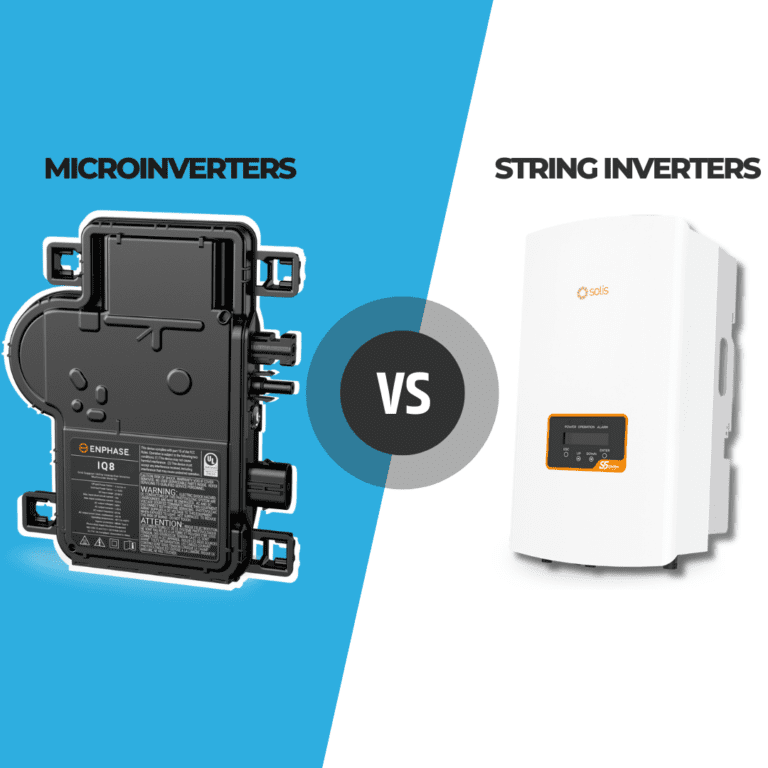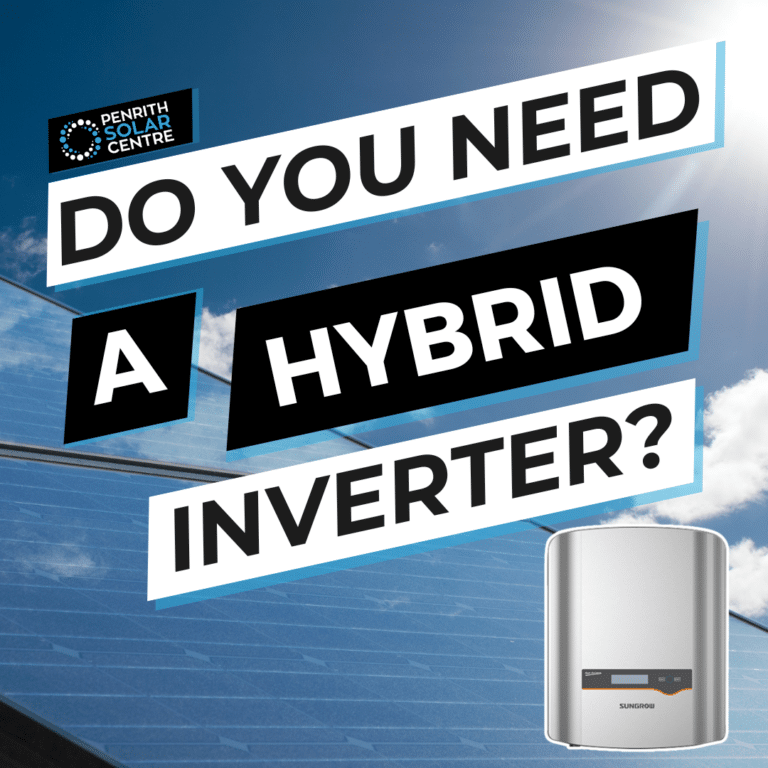Okay, let’s talk about battery retrofits (“retrofit” is a fancy vocab word in the solar industry that – in this context – means to “add later”). Currently, Australia only has about 30% of rooftop solar system penetration, which is tremendous.
Unfortunately, some of those systems don’t have batteries attached to them. The only way to fully self-consume your solar energy and not import from the grid is with a solar battery.
At Penrith Solar Centre, we understand why you might have some hesitancy when it comes to upgrading your solar system. A solar battery is a significant upfront cost, and without experts to walk you through the process, you might feel like you’re wasting money. We’re here to provide you with a transparent look at what is involved when you add a battery to your solar system.
In this article, you will learn:
- What Are the Benefits of Adding a Solar Battery to Your System?
- Are Solar Batteries Expensive?
- Does a Solar Battery Make Sense for You?
- Which Solar Battery Should You Choose?
By the end of this article, you’ll have a much clearer picture of what to consider when buying a solar battery.
What Are the Benefits of Adding a Solar Battery to Your System?
Solar panels only work when there is sunlight shining on them. The sun does not shine all twenty-four hours in a day. This isn’t especially newsworthy. Even toddlers understand how shadows work.
However, if you add a solar battery to your solar system, you’ll be able to use energy from your panels when the sun isn’t shining on them. This isn’t especially newsworthy either. Batteries have been around for a bit – the secret’s out.
We’re not trying to be cute about this. There’s resistance from most customers who contact us when it comes to adding a battery to a solar system. Mostly, the resistance is to the additional upfront cost of adding a battery to your solar.
There are many benefits to adding a solar battery, benefits that outweigh the upfront costs.
Energy Independence:
Solar batteries offer energy independence. By storing surplus energy produced by your solar panels during daylight hours, you can use it during the night or when it’s overcast.
As weather patterns grow increasingly erratic, instances of severe weather are increasing. Having a solar system equipped with a battery can offer peace of mind during inevitable power disruptions caused by storms, heat waves, and other irregular weather.
By having backup power stored in your battery, you’ll have electricity during blackouts. If you have any medical equipment that needs to remain on, or if you need a charged cell phone, a battery makes sure it stays functional.
Integrating a battery enhances your control over energy usage and provides greater peace of mind.
Lower Electric Bills:
Batteries optimise energy usage, especially during peak demand periods. Electricity prices often surge at different times (such as evenings) due to increased demand. Typically, rates are lower during the middle of the day and higher in the evening when demand peaks.
A battery can store solar energy when rates are lower and use it during peak hours when rates are higher. The money you save bypassing the grid will add up to daily savings, which results in long-term savings.
Solar batteries come equipped with management software to monitor your solar system’s energy usage. This software syncs with a mobile app, providing real-time updates on energy usage patterns. Adjusting the battery to charge or discharge based on energy rates is simple with a Powerwall 3 or an Enphase IQ Battery 5P.
While solar batteries entail an initial investment, the benefits outweigh the costs over time. Savings accumulate gradually on your monthly electricity bill. Although the upfront expense may seem substantial, most solar systems paired with batteries recoup their costs because of how much you save by not paying for electricity from the grid.
Environmental Impact:
Adding a battery to your solar setup benefits the environment. Like, a lot. Grid electricity is generated from fossil fuels, which release greenhouse gases, which is why the sun is so intense in Sydney – fossil fuel pollution is the reason you need to wear so much sunscreen in Australia.
By relying more on your own clean energy, you significantly decrease the need for the grid, fossil fuels, and all those nasty emissions. It cuts your carbon footprint. How much, exactly, depends on factors such as your solar system’s size, battery capacity, and energy usage patterns.
Are Solar Batteries Expensive?
Yes, yes, they are.
However:
When you’re shopping for a solar battery, you’ll want to factor in the long-term savings over the lifespan of the battery and the solar on the roof. We mentioned the upfront cost of the solar batteries that we install, but their price is significantly lower due to the value they provide.
What’s the difference between upfront cost and price?
The price of the solar system with a battery decreases over time as the system pays for itself against the rapidly rising energy rates. There have been two significant energy price hikes in the last year. It’s not a question of “if” there will be others, it’s a question of “how many” and “how significant” they will be.
The value of your system, with a battery added on, increases (sometimes very quickly) as time passes and energy prices increase.
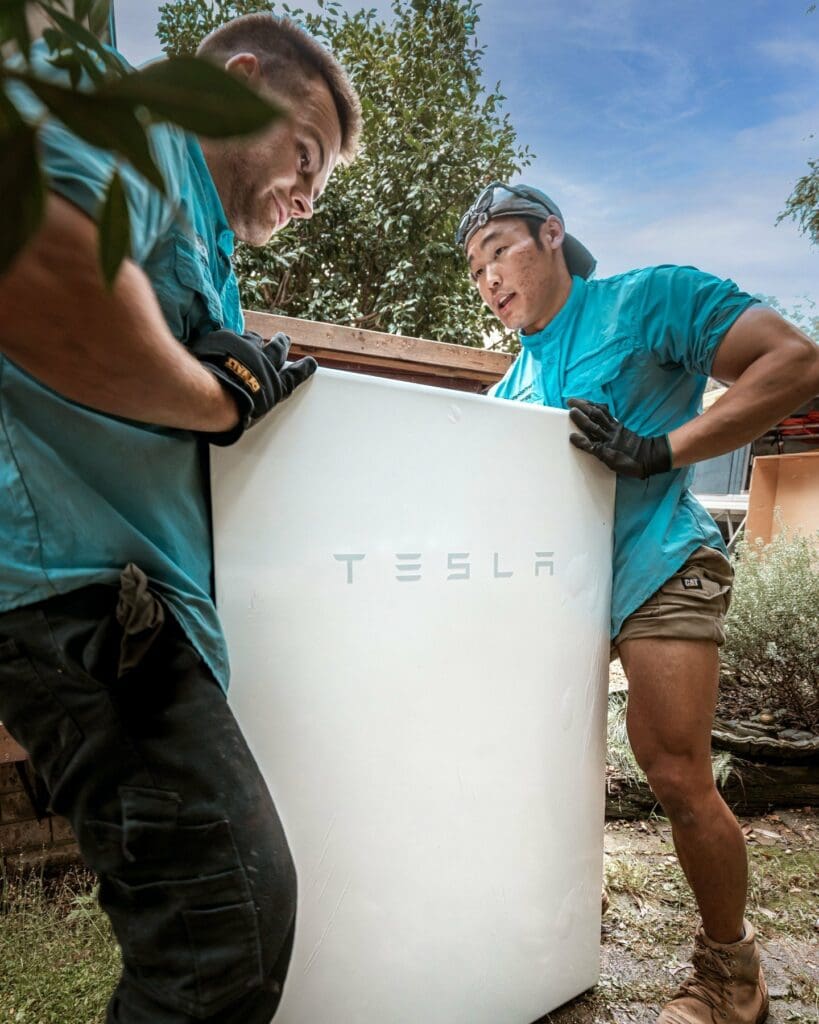
If you’re interested in learning more about solar batteries, particularly one we mentioned above, you might want to check out the following articles titled, How Much Does an Enphase IQ Battery 5P Cost?
Click here for solar solutions!
Does Adding a Solar Battery Make Sense for You?
It might. It really depends on your unique energy needs and what your goals are.
A solar battery will save the planet, save you money long-term, and protect you during blackouts.
There are a lot of options for solar batteries. When you buy solar, we recommend building the best system available to you at the time of installation.
Is Your System Battery Ready:
Can you even add a solar battery to your system?
Many of our customers want the option to add a battery later. They’re often told that the system might be “battery-ready” or that a battery can be added later. The reality is that not every battery can be installed at a later date.
An AC-coupled solar battery can be added on to almost any solar system. You can add an IQ Battery or another AC-coupled option (like an AC-coupled Powerwall 3) to nearly any solar system. And it will be extremely effective if the solar produces enough excess energy during the day to charge it (if the system is big enough).
Quite often at Penrith Solar Centre, we have customers approach us with an older one-to-one-and-a-half kilowatt system already on their roof. It hasn’t been able to keep up with rising electricity bills. They want to add a solar battery to that system.
Unfortunately, that’s never going to fully charge solar batteries in the class of 10 kilowatt hours (kWh). You need a minimum, in our opinion, of at least 5 kilowatts of solar on the roof to warrant a battery. Otherwise, it will struggle to charge and feed the home. You might need your solar installer to rip the old system off the roof, giving you an ability to pair solar with a battery such as the Powerwall 3, which is designed to be installed with solar.
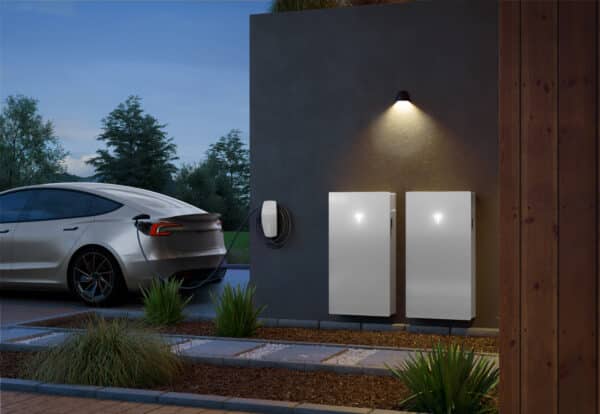
Money Back Via Feed-in Tariffs:
Batteries are typically set up for maximum self-consumption. This means that during the day, solar energy first powers the home, then any excess energy is stored in the battery, and only when the battery is full will excess energy be sold back to the grid.
Solar panels often produce more electricity than you can immediately use in your home. As mentioned, without a battery, surplus energy is sent back to the grid.
The utility company compensates you for this surplus energy through feed-in tariffs, which are payments for electricity supplied from the solar on your home to the grid. Originally, these tariffs were introduced to encourage the use of renewable energy and assist the grid during peak hours.
With time-of-use metering and virtual power plants, people are maximising their return on investment with batteries. They not only use stored energy but also sell it back to their energy retailers when prices are high, making their energy earn money for them. Unfortunately, the value of feed-in tariffs is declining as more people adopt solar energy. Rates can range from $0.04 to $0.15 per kilowatt-hour (kWh), depending on your utility company. Many homeowners are no longer benefiting from feed-in tariff rates as they once did.
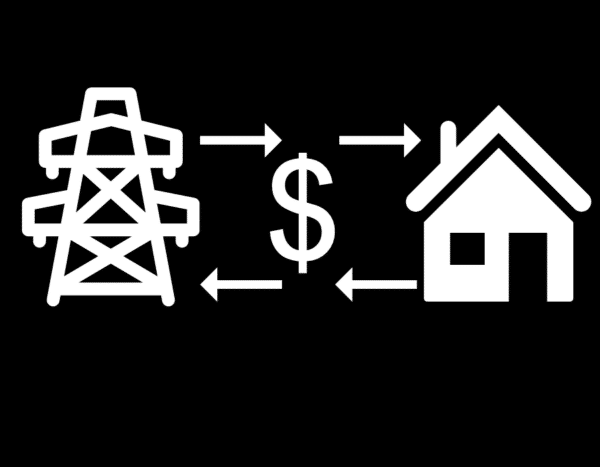
You Down with VPP? (Yeah, You Know Me!):
A VPP is a virtual power plant. One solar system with a battery working alone can’t do much to relieve the electrical grid during our current energy crisis. But if you were to connect thousands of solar systems with batteries and use that energy to relieve the stress on the electrical grid, then you’d be in business.
That’s what a VPP does.
In exchange for sharing control of your solar battery, participating households receive benefits. Let’s get into those.
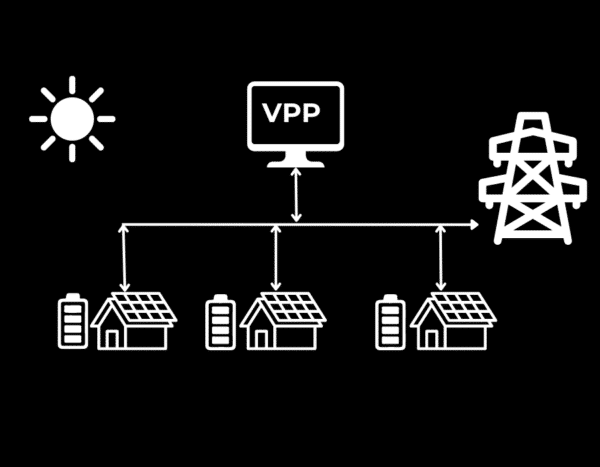
Some VPPs offer monthly payments that can be extremely helpful for households with solar batteries. Those payments add up over time.
We mentioned how the overall cost of a feed-in tariff has dropped to around $0.04 – 0.15 per kilowatt hour. A VPP will often offer a significant price jump from a typical feed-in tariff for your solar electricity when it calls for it. This is called a time-of-use tariff.
The price per kilowatt hour (kWh) for a VPP time-of-use tariff can range widely depending on the VPP and time of day they use your solar battery to discharge and relieve the grid. There are a lot of terms and conditions that need to be met to get the high end of that payout. You might also want to shop around for the highest-paying energy retailer.
If you’re interested in learning more about VPPs, you might want to check out the following article titled, What is a Virtual Power Plant (VPP)?
Which Solar Battery Should You Choose?
Are you more interested in the Enphase IQ Battery 5P, or would you prefer the Tesla Powerwall 3?
We’ve created a handy chart with some notes explaining each category. This is intended to give you a quick glimpse at each battery’s strengths and weaknesses.
In order to make it a fair fight, the statistics included are two Enphase IQ Battery 5Ps against one Tesla Powerwall 3 – it evens the odds a bit and provides a better comparison (because the Enphase battery has half the storage at half the price).
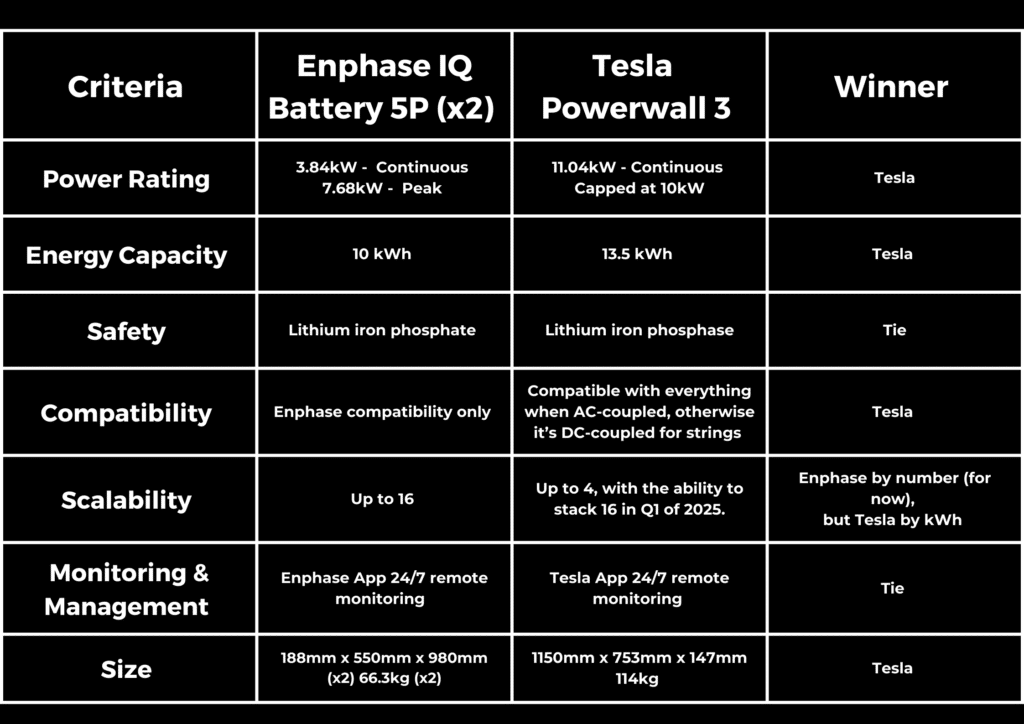
Power Rating: Power, measured in kilowatts (kW), is how electricity moves through wires or devices, similar to water flowing through a hose.
In the table above, there are two power ratings for the IQ Battery: continuous and peak. Continuous power shows how much electricity can be used steadily over time without interruption. Enphase has a continuous power rating of 3.84kW, while Powerwall is rated at 11.04kW (which must be capped at 10kW due to regulations from NSW local DNSPs).
Peak power, however, is like a quick burst of electricity. It measures how much power the battery can release for a short period, usually about ten seconds. Enphase’s peak power discharge is 7.68kW for 3 seconds and 6.14kW for 10 seconds. For Powerwall, it smokes the IQ Battery with 10kW of continuous power.
Energy Capacity: Think of energy capacity like a bucket storing water. Even when stacking two Enphase IQ Battery 5Ps together at 10kWh, they can’t achieve the same storage as the Powerwall 3 at 13.5kWh.
Safety: The batteries use identical chemistries. Lithium iron phosphate is safer at higher temperatures and is cobalt-free. It’s also easier to recycle.
Compatibility: Enphase batteries only work with Enphase microinverter solar systems or other Enphase IQ Battery 5Ps. Powerwall is compatible with many systems when AC-coupled. However, it can be installed as a DC-coupled battery too. It’s practically brand-agnostic.
Scalability: Both batteries are equally stackable (that’s a fancy solar industry term that means you can connect the batteries together to work as one, much bigger battery).
Monitoring and Management: Both batteries have similar monitoring systems, but the Tesla App only works on Apple or Android devices, not in web browsers.
Size: The Powerwall is massive compared to the Enphase IQ. It weighs nearly twice as much and takes up more room wherever it’s installed. The footprint of the Enphase battery is smaller; however, we’re using the stats for two of them so in this example it will double its footprint in your home.
Imitation is the Sincerest Form of Battery
Now you understand some of the factors that you should consider as you weigh the decision to purchase a solar battery. There’s the issue of cost, of course, but when compared to the lifelong price of the system, you’ll be saving money. But you’ll also be doing some good for the environment and gaining independence from the grid.
At Penrith Solar Centre, we’re experts in walking customers through their needs and goals to determine if a solar battery is a suitable option or not. There’s a lot to consider, and we consider these factors every single day.
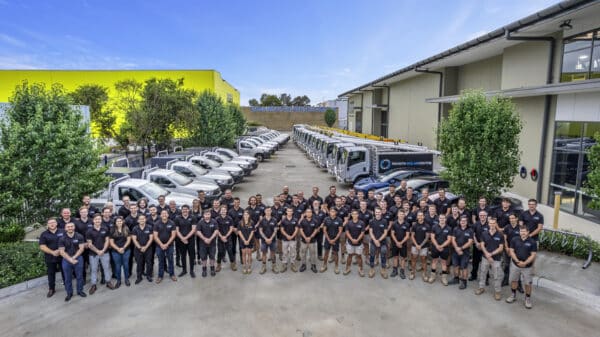
If you’re interested in learning more about solar batteries, you might want to check out the following article titled, Enphase IQ Battery 5P vs Tesla Powerwall 2: Which is Right for You?

